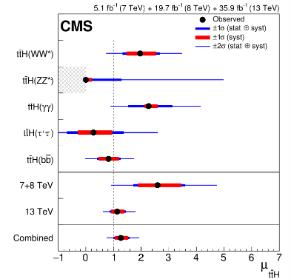
New results from the ATLAS and CMS experiments at the LHC reveal how strongly the Higgs boson interacts with the heaviest known elementary particle, the top quark, corroborating our understanding of the Higgs and setting constraints on new physics.
The Higgs boson interacts only with massive particles, yet it was discovered in its decay to two massless photons. Quantum mechanics allows the Higgs to fluctuate for a very short time into a top quark and a top anti-quark, which promptly annihilate each other into a photon pair. The probability of this process occurring varies with the strength of the interaction (known as coupling) between the Higgs boson and top quarks. Its measurement allows us to indirectly infer the value of the Higgs-top coupling. However, undiscovered heavy new-physics particles could likewise participate in this type of decay and alter the result. This is why the Higgs boson is seen as a portal to new physics.
A more direct manifestation of the Higgs-top coupling is the emission of a Higgs boson by a top-antitop quark pair. Results presented today, at the LHCP conference in Bologna, describe the observation of this so-called "ttH production" process. Results from the CMS collaboration, with a significance exceeding five standard deviations (considered the gold standard) for the first time, have just been published in the journal Physical Review Letters; including more data from the ongoing LHC-run, the ATLAS collaboration just submitted new results for publication, with a larger significance. Together, these results are a great step forward in our knowledge of the properties of the Higgs boson. The findings of the two experiments are consistent with one another and with the Standard Model, and give us new clues for where to look for new physics.
“These measurements by the CMS and ATLAS Collaborations give a strong indication that the Higgs boson has a key role in the large value of the top quark mass. While this is certainly a key feature of the Standard Model, this is the first time it has been verified experimentally with overwhelming significance,” said Karl Jakobs, Spokesperson of the ATLAS collaboration.
“The CMS analysis teams, and their counterparts in ATLAS, employed new approaches and advanced analysis techniques to reach this milestone. When ATLAS and CMS finish data taking in November of 2018, we will have enough events to challenge even more strongly the Standard Model prediction for ttH, to see if there is an indication of something new,” declared Joel Butler, Spokesperson of the CMS collaboration.
Measuring this process is challenging, as it is rare: only 1% of Higgs bosons are produced in association with two top quarks and, in addition, the Higgs and the top quarks decay into other particles in many complex ways, or modes. Using data from proton–proton collisions collected at energies of 7, 8, and 13 TeV, the ATLAS and CMS teams performed several independent searches for ttH production, each targeting different Higgs-decay modes (to W bosons, Z bosons, photons, τ leptons, and bottom-quark jets). To maximise the sensitivity to the experimentally challenging ttH signal, each experiment then combined the results from all of its searches.
It is gratifying that this result has come so early in the life of the LHC programme. This is due to the superb performance of the LHC machine and of the ATLAS and CMS detectors, the use of advanced analysis techniques and the inclusion of all possible final states in the analysis. However, the precision of the measurements still leaves room for contributions from new physics. In the coming years, the two experiments will take much more data and improve the precision to see if the Higgs reveals the presence of physics beyond the Standard Model.
“The superb performance of the LHC and the improved experimental tools in mastering this complex analysis led to this beautiful result,” added CERN Director for Research and Computing Eckhard Elsen. “It also shows that we are on the right track with our plans for the High-Luminosity LHC and the physics results it promises.”
Researchers at the UAM Departamento de Física Teórica participate in both the ATLAS and CMS experiments.
Universidad Autónoma de Madrid © 2008 · Ciudad Universitaria de Cantoblanco · 28049 Madrid